Complete Solutions to QUESTIONS of chapter SPECIMEN QUESTION PAPER of Class 12 book with complete answers and questions
| Class 12 | BIOLOGY |
| Chapter | SPECIMEN QUESTION PAPER |
| OSWAL GURUKUL | QUESTIONS |
| Number Of Questions | 67 |
| Academic Year | 2023-24 |
Which of the following steps in transcription is catalysed by RNA polymerase?
View SolutionIn a DNA strand the nucleotides are linked together by
View SolutionIf the sequence of nitrogen bases of the coding strand of DNA in a transcription unit is: 5' - ATGAATG-3', the sequence of bases in its RNA transcript would be
View SolutionIn E. coli the lac operon gets switched on when
View SolutionThe amino acid attaches to the tRNA at its
View SolutionWhich of the following provides the most satisfactory evidence in the favour of the organic evolution?
View SolutionWhich era is dubbed as the age of prokaryotic microbes?
View SolutionThe presence of gill slits in the embryos of all vertebrates supports the theory of:
View SolutionIn Miller's experiment, the gaseous mixture in the flask contained:
View SolutionNeo-Darwinism is:
View SolutionTrichoderma, free living fungi, present in root ecosystem are useful as:
View SolutionDuring spermatogenesis, the second maturation division results in the formation of:
View SolutionWhat is the effect of high pH on sperm?
View SolutionIf temperature is reduced to `0^@C`, what will happen to spermatozoa?
View SolutionSelect the incorrect statement about gametes:
View SolutionIn industries, citric acid is obtained from which of the following the microbe?
View SolutionStatins are used as:
View SolutionBiological name of the common yeast used in baking industry is:
View SolutionWhich of the following microbes is used in the production of Swiss cheese?
View SolutionWhich of the following can be used as biofertilizer?
View SolutionThe abbreviation 'HIV' stands for:
View SolutionThe abbreviation snRNA stands for:
View SolutionThe fact that DNA is the genetic material was proved by:
View SolutionThe term biodiversity was coined by:
View SolutionBt cotton is a/an ____ resistant variety of cotton.
View SolutionBt cotton has been produced by transferring genes of _____ into the cotton plant.
View SolutionThe enzyme pectinase is obtained from:
View SolutionThe enzyme ______ is used to remove the turbidity and clear the fruit juices:
View SolutionSecondary sewage treatment is mainly a _____ process:
View SolutionCorpus luteum has _____ function:
View SolutionThe hormone _(A)_, released by _(B)_ helps in the release of milk from the mammary glands.
View SolutionIf the mother is homozygous for blood group B, and the father is heterozygous for blood group A, their offspring will be of ____ and __ blood groups:
View SolutionThe vermiform appendix is _____ organ in humans.
View SolutionThe sperm of Drosophila contains ____ number of chromosomes:
View SolutionWhich of the following is not correct regarding vasectomy?
View SolutionWhich of the following statements is correct?
View SolutionWhich of the following is odd one out with reference to evolution ?
View SolutionWhich of the following is odd one out with reference to geological time scale?
View SolutionAssertion: All the plants belonging to a single clone are phenotypically identical.
Reason: All the plants within a clone are derived from vegetative cells through mitosis and have the same genetic constitution.View SolutionAssertion: Autosomal disease is transferred from father to both son and daughter.
Reason: Autosomes are transferred only from father to son.View SolutionAssertion: Tropical latitudes have greater biological diversity temperate latitudes.
Reason: Tropical regions remain relatively undisturbed for millions of years.View SolutionAssertion: Methane component of greenhouse gases contributing to global warming is about 20%.
Reason: Introduction of multi-point fuel injection increase methane production engines in automobiles has decreased methane content in the exhausts.View SolutionAssertion: Mendel conducted his experiments on Pisum sativum.
Reason: Pisum sativum belongs the family Solanaceae.View SolutionStudy the diagram given below and answer the questions that follow:

The alphabet 'A' represents ______ hormone.View SolutionStudy the diagram given below and answer the questions that follow:
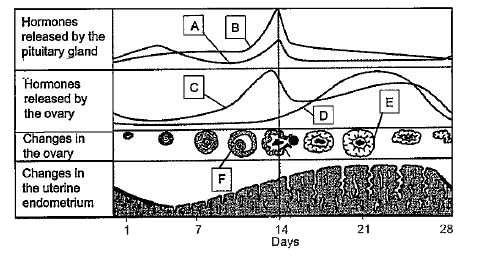
The alphabet 'D' represents ______ hormone.View SolutionStudy the diagram given below and answer the questions that follow:
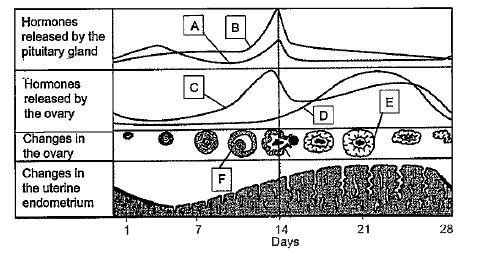
The structure marked 'E' is ______View SolutionStudy the diagram given below and answer the questions that follow:

Ovulation occurs on day _______ of a typical menstrual cycle.View SolutionStudy the diagram given below and answer the questions that follow:

Menstrual cyde operates in ______View SolutionThe pedigree chart given below represents the pattern of inheritance of haemophilia in a family. Study it carefully and answer the following questions:
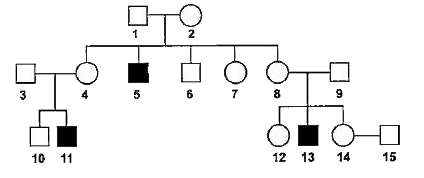
Identify the correct statement with respect to member '4':View SolutionThe pedigree chart given below represents the pattern of inheritance of haemophilia in a family. Study it carefully and answer the following questions:
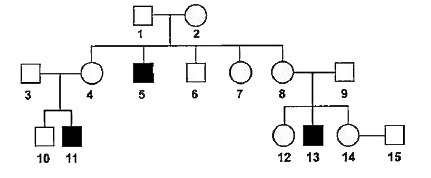
The possible genotype of member '5' is:View SolutionThe pedigree chart given below represents the pattern of inheritance of haemophilia in a family. Study it carefully and answer the following questions:

The possible genotype(s) of member '6' is/are:View SolutionThe pedigree chart given below represents the pattern of inheritance of haemophilia in a family. Study it carefully and answer the following questions:
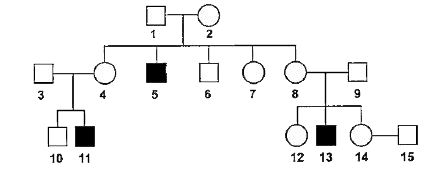
Haemophilia is a/an ______ traitView SolutionThe diagram of the organs of female reproductive system is given below. Study it carefully and answer the questions that follow:

The place where fertilisation takes place is:View SolutionThe diagram of the organs of female reproductive system is given below. Study it carefully and answer the questions that follow:

The place where the embryo is implanted:View SolutionThe diagram of the organs of female reproductive system is given below. Study it carefully and answer the questions that follow:

The ovum is released by:View SolutionThe diagram of the organs of female reproductive system is given below. Study it carefully and answer the questions that follow:

The hormone testosterone is released by:View SolutionThe diagram of the organs of female reproductive system is given below. Study it carefully and answer the questions that follow:

The _____ layer of the organ 'C' undergoes a cyclic change every month:View SolutionRead the passage given below, and answer the questions that follow:
The cotton bollworm is considered a major pest, all over the world. Due to its destructive feeding nature and continuous consumption of the same chemicals, it evolved resistant against many insecticides. To overcome this problem, scientists introduced a virus which selectively infects and kills the bollworm.
The virus used in this process was:View SolutionRead the passage given below, and answer the questions that follow:
The cotton bollworm is considered a major pest, all over the world. Due to its destructive feeding nature and continuous consumption of the same chemicals, it evolved resistant against many insecticides. To overcome this problem, scientists introduced a virus which selectively infects and kills the bollworm.
In scientific terms, this method of pest control is an example of:View SolutionRead the passage given below, and answer the questions that follow:
The cotton bollworm is considered a major pest, all over the world. Due to its destructive feeding nature and continuous consumption of the same chemicals, it evolved resistant against many insecticides. To overcome this problem, scientists introduced a virus which selectively infects and kills the bollworm.
The advantage of this process is that it helps in:View SolutionRead the passage given below, and answer the questions that follow:
The cotton bollworm is considered a major pest, all over the world. Due to its destructive feeding nature and continuous consumption of the same chemicals, it evolved resistant against many insecticides. To overcome this problem, scientists introduced a virus which selectively infects and kills the bollworm.
The virus used in this process can also be used to control some mosquito-borne diseases like:View SolutionRead the passage given below, and answer the questions that follow:
The cotton bollworm is considered a major pest, all over the world. Due to its destructive feeding nature and continuous consumption of the same chemicals, it evolved resistant against many insecticides. To overcome this problem, scientists introduced a virus which selectively infects and kills the bollworm.
From the statements given below, select the correct statement with respect to this process:View SolutionRead the passage given below, and answer the questions that follow:
Some students wanted to investigate the pattern of inheritance of flower colour in snapdragon. They selected some plants which were homozygous for red flowers and some other plants which were homozygous for white flowers. These plants were labelled as Parental Plants `(P_1)`. These plants (red-flowered and white flowered), were cross-pollinated. The seeds obtained from these plants were planted in a separate field. These seeds germinated to produce the plants which were labelled as the plants of `F_1`-generation.
Based on the above experiment, answer the following questions:
Select the statement which correctly predicts the phenotype of the plants of `F_1` generation.View SolutionRead the passage given below, and answer the questions that follow:
Some students wanted to investigate the pattern of inheritance of flower colour in snapdragon. They selected some plants which were homozygous for red flowers and some other plants which were homozygous for white flowers. These plants were labelled as Parental Plants `(P_1)`. These plants (red-flowered and white flowered), were cross-pollinated. The seeds obtained from these plants were planted in a separate field. These seeds germinated to produce the plants which were labelled as the plants of `F_1`-generation.
Based on the above experiment, answer the following questions:
If the plants of `F_1`-generation are allowed to self-pollinate, then in `F_2`-generation.View SolutionRead the passage given below, and answer the questions that follow:
Some students wanted to investigate the pattern of inheritance of flower colour in snapdragon. They selected some plants which were homozygous for red flowers and some other plants which were homozygous for white flowers. These plants were labelled as Parental Plants `(P_1)`. These plants (red-flowered and white flowered), were cross-pollinated. The seeds obtained from these plants were planted in a separate field. These seeds germinated to produce the plants which were labelled as the plants of `F_1`-generation.
Based on the above experiment, answer the following questions:
The genotypic ratio of the plants of `F_2`-generation will be:View SolutionRead the passage given below, and answer the questions that follow:
Some students wanted to investigate the pattern of inheritance of flower colour in snapdragon. They selected some plants which were homozygous for red flowers and some other plants which were homozygous for white flowers. These plants were labelled as Parental Plants `(P_1)`. These plants (red-flowered and white flowered), were cross-pollinated. The seeds obtained from these plants were planted in a separate field. These seeds germinated to produce the plants which were labelled as the plants of `F_1`-generation.
Based on the above experiment, answer the following questions:
This type of inheritance can be described as:View SolutionRead the passage given below, and answer the questions that follow:
Some students wanted to investigate the pattern of inheritance of flower colour in snapdragon. They selected some plants which were homozygous for red flowers and some other plants which were homozygous for white flowers. These plants were labelled as Parental Plants `(P_1)`. These plants (red-flowered and white flowered), were cross-pollinated. The seeds obtained from these plants were planted in a separate field. These seeds germinated to produce the plants which were labelled as the plants of `F_1`-generation.
Based on the above experiment, answer the following questions:
The biological name of snapdragon is:View Solution
QUESTIONS questions and complete solutions for chapter SPECIMEN QUESTION PAPER of SRIJAN BIOLOGY (ENGLISH) of Class 12
